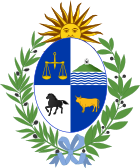 |
|---|
|
|
A double referendum on constitutional reform was held in Uruguay on 27 March 1938. Both sets of reforms were approved by voters. [1] [2]
The first set of reforms had been proposed in a constitutional law on 30 December 1936. [1] They would recognise the " lema" system of factions within political parties and allow several presidential candidates for each lema. [1] The most voted for candidate from the most voted for lema would win the presidential election. [1] The law would also reorganise the Senate. [1]
The second set of reforms were put forward by the General Assembly on 24 February 1938. [2] They would restrict each lema to a single candidate for president, as well as reorganising local government. [2] As this was an administrative initiative by two-fifths of the Assembly, a majority of registered voters voting in favour was required. [2] This was achieved, with 52.47% of all registered voters approving the reforms. [2]
| Choice | Votes | % |
|---|---|---|
| For | 333,802 | 93.45 |
| Against | 23,385 | 6.55 |
| Invalid/blank votes | – | |
| Total | 357,187 | 100 |
| Registered voters/turnout | 636,171 | |
| Source: Direct Democracy | ||
| Choice | Votes | % |
|---|---|---|
| For | 333,802 | 97.99 |
| Against | 6,847 | 2.01 |
| Invalid/blank votes | – | |
| Total | 340,649 | 100 |
| Registered voters/turnout | 636,171 | |
| Source: Direct Democracy | ||
 |
|---|
|
|
A double referendum on constitutional reform was held in Uruguay on 27 March 1938. Both sets of reforms were approved by voters. [1] [2]
The first set of reforms had been proposed in a constitutional law on 30 December 1936. [1] They would recognise the " lema" system of factions within political parties and allow several presidential candidates for each lema. [1] The most voted for candidate from the most voted for lema would win the presidential election. [1] The law would also reorganise the Senate. [1]
The second set of reforms were put forward by the General Assembly on 24 February 1938. [2] They would restrict each lema to a single candidate for president, as well as reorganising local government. [2] As this was an administrative initiative by two-fifths of the Assembly, a majority of registered voters voting in favour was required. [2] This was achieved, with 52.47% of all registered voters approving the reforms. [2]
| Choice | Votes | % |
|---|---|---|
| For | 333,802 | 93.45 |
| Against | 23,385 | 6.55 |
| Invalid/blank votes | – | |
| Total | 357,187 | 100 |
| Registered voters/turnout | 636,171 | |
| Source: Direct Democracy | ||
| Choice | Votes | % |
|---|---|---|
| For | 333,802 | 97.99 |
| Against | 6,847 | 2.01 |
| Invalid/blank votes | – | |
| Total | 340,649 | 100 |
| Registered voters/turnout | 636,171 | |
| Source: Direct Democracy | ||